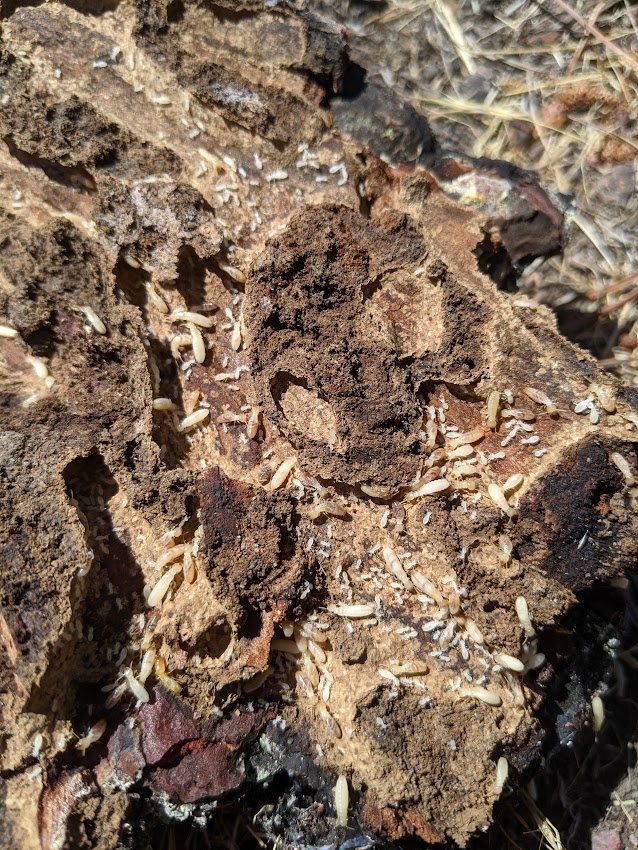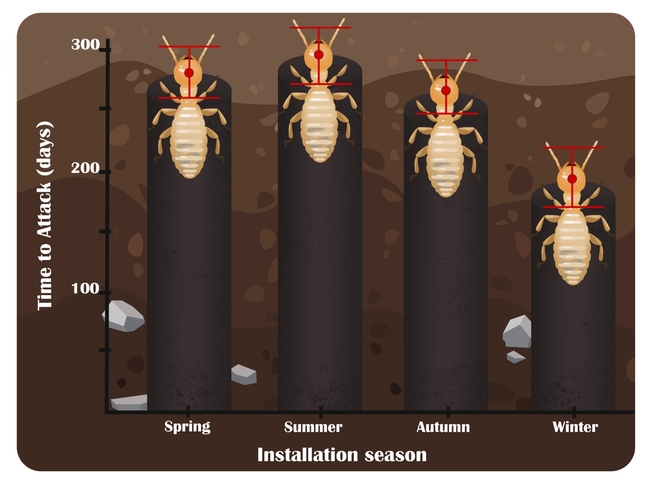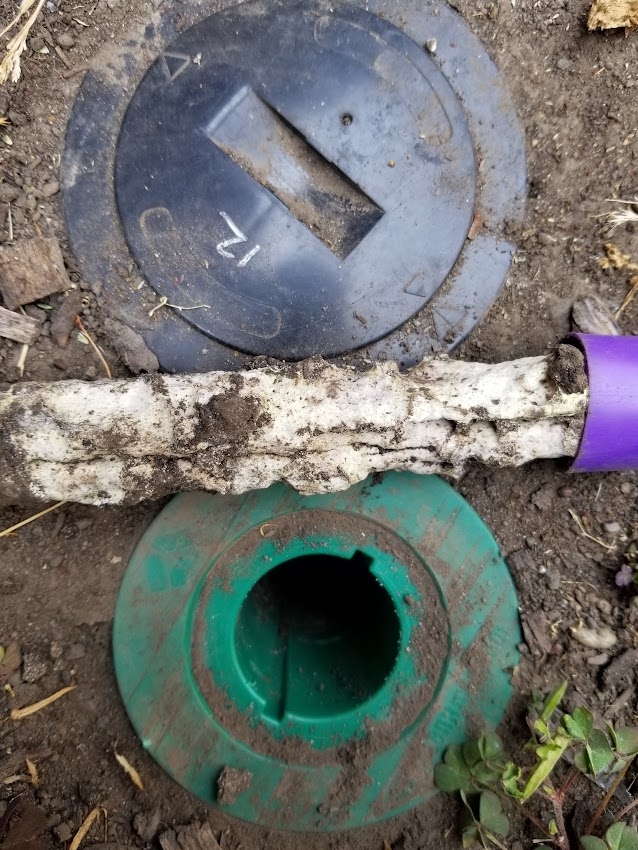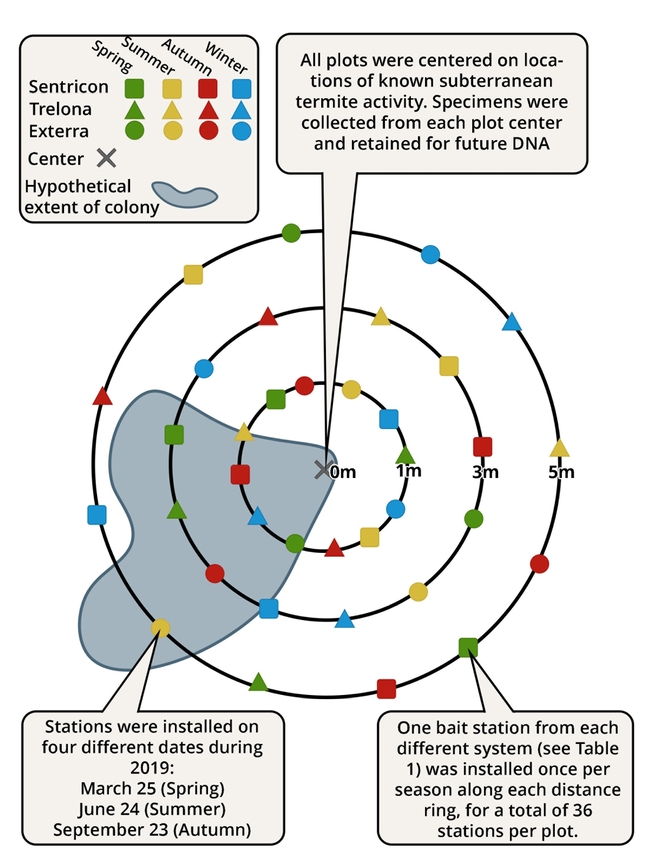Baits Eliminate and Prevent Subterranean Termite Colonies

Subterranean termites (Family Rhinotermitidae) are considered the most serious wood-destroying pests in the world, causing an estimated $32 billion in global economic impact each year. California is home to both native and introduced subterranean termite species (Figure 1). Infestations of wooden structures are widespread and common. Pest control operators (PCOs) have conventionally applied liquid termiticides to control these pests, usually as soil drenches or injections around structures. These treatments may not always be effective, however, especially if good underground coverage is not achieved, if local termite pressure is very high, or if dealing with the invasive Formosan subterranean termite in Southern California. Furthermore, the active ingredients in most liquid termiticides are increasingly monitored by the State as environmental contaminants and may be subject to legal restrictions in the future.
Bait systems for subterranean termites (Figure 2), which employ slow-acting insecticides that kill worker termites by preventing successful molting, may represent effective alternatives to liquid treatments. Baits, deployed within stations installed in the ground or in line with aboveground shelter tubes, have gained popularity during recent decades and are now considered the primary subterranean termite control tactics in many parts of the world. Adoption of bait systems in California has lagged most other regions, however. Reasons PCOs in California have reported being reluctant to use bait systems include 1) time required to achieve control is too long, 2) little efficacy data in California, and 3) the regular monitoring of bait systems is too labor intensive or otherwise does not fit established business models.
Recently, the third “adoption barrier” may have become less important: new product label guidelines allow PCOs to extend inspection intervals up to 12 months and allow for baiting without the previously required monitoring phase (provided the target pest is confirmed at the site). Considering the regular revenue streams created by “controlled service agreements”, where PCOs contract with property owners to prevent and control pests over a long term, these newer labels should drive more widespread use.
Some observations and case studies indicate that, indeed, bait system adoption is now slowly increasing in California. To address the other two reported barriers (speed of control and efficacy), we secured funds from the state's Structural Pest Control Board to evaluate and demonstrate three different in-ground bait systems in the San Francisco Bay Area and the greater Los Angeles area.
Bait Efficacy
Our first objective was to evaluate efficacy at single-family homes. To do this, we collaborated with five different PCO companies who expressed interest in the new business models made possible by the newer bait product labeling guidelines. Some of these companies had experience with baits, while some gained their first experiences through this project. Companies received research stipends to subsidize their participation. Fifteen single-family homes were eventually selected, based on several experimental criteria: 1) documented activity of subterranean termites within 1 meter of the structure, 2) no liquid termiticide application within the previous 5 years, and 3) no significant structural infestations detected during the initial inspection. Participating homes were in Alameda, Contra Costa, Los Angeles, Orange, and Santa Clara counties. Bait stations, baits, service equipment, and, in some cases, training, were provided by manufacturers.
The UC research team and the PCOs installed bait systems according to product labels, usually with one bait station for every 10–20 linear feet of the structural perimeter. Since all 15 sites had confirmed termite activity at the perimeter, all stations installed contained active bait, rather than monitors. The UC research team installed monitoring stations with wooden blocks immediately adjacent to each bait station. The UC team then visited each participating home every 3 months for 2 years, checking termite activity within monitoring stations and collecting termites whenever possible. The PCOs and the UC team visited each participating home every 6 months to check termite activity within bait stations, replenish baits (as per product label), and to collect termites. Collected termite specimens were sent to a collaborating lab for DNA analysis, where each sample was assigned a “Colony ID” based on its genetic signature, distinguishing it from all other colonies. At the end of the 2-year period, a final structural inspection was conducted at each home.
Findings
Most importantly, despite significant termite pressure, none of the 15 homes became infested during the study period. Foraging termites were observed and collected during initial inspections, from wood blocks during quarterly inspections, and from bait matrices during bi-annual inspections with PCOs. In some cases, termites were observed and collected from bait stations only 6 months after installation. 132 separate samples of western subterranean termites (Reticulitermes hesperus species complex) were collected. DNA analysis revealed that many of our research sites included between 3 and 5 unique colonies; 1 property included 15 unique colonies! Bait was consumed at all sites, to varying degrees. No termite colony recovered from bait stations was ever detected again.
These observations strongly suggest that all three studied bait systems were effective at eliminating termite colonies and at preventing structural infestations over a 2-year period. Furthermore, post-project surveys conducted with property owners and PCOs indicated that all parties were satisfied with the services provided and control achieved; several companies new to baiting have now embraced the program we demonstrated as a new service offering for their customers.
Reducing “time-to-attack”
Our second objective in this research project was to investigate factors influencing bait interception time (also called “time-to-attack”). One explanation for lengthy bait interception times in California may be the interaction of climate (hot summers with little to no rain) and soil texture (high proportions of clay). Termite foraging at or near the soil surface may be limited or even nonexistent during summer months, especially when areas are not irrigated. Some research supports this idea: western subterranean termites have been observed to forage near the surface mostly during winter months in Southern California. This suggests that baits installed in summer may sit uninvestigated for 6 months or more. To test this hypothesis, we established five research plots at the UC Berkeley Richmond Field Station directly on top of areas where naturally occurring Reticulitermes termites had been observed or collected. Around these areas, we established 3 concentric rings of bait stations at 3 distances from the center, installing 1 station from each of 3 registered systems (Table 1) along each of the 3 distance rings at the beginning of each season over 1 year, for a total of 36 bait stations per plot. We didn't want to kill the termites in these plots because that would significantly confound our data, so we used cellulose bait matrices from manufacturers that did not contain the active ingredients. We also installed monitoring stations containing wood blocks at the center of each plot and along each of the three distance rings. We then checked each station every 2 months for 2 years, recording bait consumption and termite incidence.
Of the 180 bait stations and 20 monitoring stations installed, 78 bait stations and 9 monitoring stations had been hit by the end of the 2-year project period, representing an overall hit rate of 44%. Three stations were attacked within 60 days after installation, and 10 stations were attacked within 120 days. Overall, however, the average bait interception time was 367 days, supporting the general claims of California's pest control operators that baiting may take too long for most remedial termite control jobs. There were no significant differences between the three bait systems or the three distance rings.
|
Bait System, Manufacturer |
Bait Information |
Installation Specifications (for in-ground use) |
Service Specifications |
|---|---|---|---|
|
Sentricon Always Active, Corteva Agriscience |
Recruit HD Termite Bait (EPA# 62719-608): cellulose tube, 0.5% noviflumuron |
≤ 20 feet intervals; buildings, fences, decking, utility poles, trees |
Inspections at least once annually; replace bait if damaged or ≥ 1/3 consumed |
|
Advance Termite Bait System (ATBS), BASF |
Trelona Compressed Termite Bait (EPA# 499-557): cellulose wafers in plastic housing, 0.5% novaluron |
≤ 20 feet intervals; buildings, trees, wood piles, landscape elements, railroads |
Inspections at least once annually; replace bait if damaged or ≥ ½ consumed |
|
Exterra Termite Baiting System, Ensystex |
Isopthor Termite Bait (EPA# 68850-2): cellulose wafers within burlap sachet, 0.25% diflubenzuron |
≤ 20 feet intervals; buildings and other structures |
Inspections every 45 – 120 d, up to six months allowed; replace bait “after sufficient consumption” |
Our study's main question was whether installation season significantly impacts “time-to-attack” due to seasonal differences in termite foraging in California. To answer this, we pooled data from all five sites and all three bait systems and then considered just the first year of observations. The result was clear: baits installed at the beginning of winter (December 16) were intercepted ~100 days faster than baits installed at the beginning of summer (June 24)!
Conclusions
Bait stations systems may be very useful pest control tactics for use against subterranean termites in California, especially when dealing with very large colonies of native western subterranean termites, multiple colonies, sensitive sites, or sites where liquid treatments have failed. According to the labels of the three products evaluated, systems can be installed with active ingredients present on Day 1, provided a licensed Field Representative has detected and identified the target species at the site. Licensed Applicators may, according to label language and California's Structural Pest Control Act, then service bait stations, replenishing bait that has been consumed or damaged. Two of the systems evaluated allow for annual inspections, while one allows for bi-annual (every 6 months) inspections. Operators in California may decrease the bait interception time, and therefore the perceived early efficacy, by targeting initial installations for the beginning of the wet season.
[Originally featured in the Fall 2023 edition of the Green Bulletin Newsletter for structural and landscape pest professionals.]

